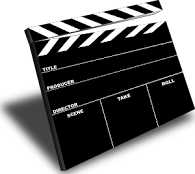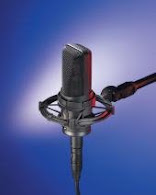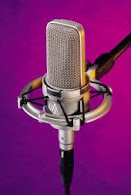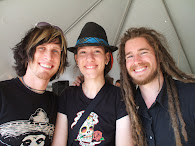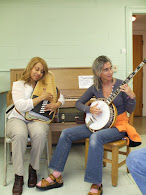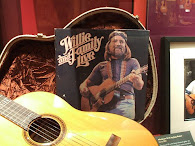 Just in time for Valentine's Day! Here's some inspiration for writing and recording that first love song. Capture your work on a radio-ready CD. Studio headphones and distressed tee by Audio-Technica.
Just in time for Valentine's Day! Here's some inspiration for writing and recording that first love song. Capture your work on a radio-ready CD. Studio headphones and distressed tee by Audio-Technica.Valentine's Day for me marks the fact that winter is slowly coming to an end. It makes me think of the romance of spring to come and inspires me to get my ideas down on paper. Where do you get such material, one may ask? I've found that the best songs begin with a page from your own life's experience. Torch songs are only effective if the singer "inhabits" the lyrics. This means that the song has to have some connection to your being. Whatever you do, you've got to have conviction. Tell the story! So how do you begin?
Got An Idea?
Some people find that the lyrics come first, pretty much like writing a poem. Then they sit down and try to construct a melody with chord progressions. If you have the opportunity, jam with some professional musicians on a regular basis. You will find a lot of ideas flowing out of a set, especially if you play a break. When you are called on to solo, you are improv ising on the spot and creating your own melody line against the written tune. This is especially true for the blues and jazz but other styles also allow this sort of free form creativity.
ising on the spot and creating your own melody line against the written tune. This is especially true for the blues and jazz but other styles also allow this sort of free form creativity.Photographed here are a few members of my musician's guild whom I regularly play with. We do mostly Bluegrass, Gospel, Folk and Country. In our workshops, we always ask if there is a song someone is working on. You kick it off and they will come in with their individual breaks and comps. This way you can hear what your song could sound like with just the right mix of bass and lead solos. If you ever get to do studio work, you'll find that most today use click tracks or drum and bass machines. Drummers are seldom used in session work anymore so it may be a good idea to get used to playing with drum and bass tracks or at least a metronome. Still, there is nothing quite like playing with a group of live, seasoned, spontaneous musicians like these guys. It's something that just can't be replicated by a machine. Get more information on jamming by reading the article, Bluegrass Season is Here: http://mariejmiczak.blogspot.com/2008/04/bluegrass-season-is-now-open.html
Recording Your Work
When I have an idea or even just the "hook" for a song, I use my MP3 player or similar digital recorder to capture the moment. This way, the little nuances in the melody or vocals can be saved. This makes it easier for when you decide to transfer your ideas to sheet music. The main thing is to seize the moment! However don't get too stuck on replicating what you did on any given day. Why? Well, that was what you were inspired to do at that particular moment. You might do it even better in a subsequent recording session. Once your preliminary work has been saved onto an MP3 file, you can download it onto your computer. This way you can share it with others.
capture the moment. This way, the little nuances in the melody or vocals can be saved. This makes it easier for when you decide to transfer your ideas to sheet music. The main thing is to seize the moment! However don't get too stuck on replicating what you did on any given day. Why? Well, that was what you were inspired to do at that particular moment. You might do it even better in a subsequent recording session. Once your preliminary work has been saved onto an MP3 file, you can download it onto your computer. This way you can share it with others.The Best Vocal Recording Mics... Audio-Technica Condensers
What is the best microphone to use to record vocals? When you are shooting for studio quality recordings, you'll need to invest in a very well made condenser mic. You can skimp on a lot of things such as studio monitors, mic stands, etc. but this is one piece of equipment you should be serious about. Condensers in general are much more sensitive and responsive as compared to dynamics. Which studio mic do I use? Audio-Technica's AT4047/SV. It comes with a matching shock mount and is the best large diaphragm, side address condenser I've ever used. Wonderfully sensitive without being testy with feedback. Adds all the polish and warmth you're looking for while setting your work apart from the rest. It actually works quite well as an instrument mic too but I stand by it for vocals. You do not have to spend $3,000.00 for a quality studio mic like this anymore! This mic has been compared to the upper priced Neumann and Sienhiesser mics by professional recording studio engineers and recording artists. The AT4047/SV more than holds its own against these and other high-priced microphones. What we especially appreciated is that the 40 Series mics all come with matching shock mount and dust cover as furnished accessories. Other microphones require that you purchase these pieces separately. As a follow up on Audio-Technica's 40 Series, we'll also be using their AT4050 Multi-pattern Condenser microphone for our recording project with C.F. Martin & Co. Visit Audio-Technica's website for all of their excellent mics at: http://www.audio-technica.com/cms/site/c35da94027e94819/index.html
Burning Your Work Onto a CD
Once you have your ideas sketched out and saved either onto your MP3 player or digital recording device, you will want to back it up by saving onto a CD. This is good to do if you want to keep a har d-copy record of your studio work and even down to your finished project. A digital recording studio allows you to "punch out" mistakes or even record alternative tracks for the same song. That's what all those radio remixes are that you hear in the clubs. Phrase looping is also easy to do with a digital recorder as is over-dubbing. Since music files eat up a huge amount of space on your computer, I would recommend getting a stand-alone recorder like the BOSS BR1200CD pictured here. It has a 40 GB hard drive, 12 tracks, (no waiting!), and mic / instrument input jacks right up front. Phantom power is also available for your condenser mics and there's a vocal effects kit as well as a mastering toolbox to give your CD that "pro" quality everyone expects today. Best of all, you have complete control over your work, from your first idea to the final production. Save alternate versions of the same song to work on later. Visit BOSS online at: http://www.bossus.com
d-copy record of your studio work and even down to your finished project. A digital recording studio allows you to "punch out" mistakes or even record alternative tracks for the same song. That's what all those radio remixes are that you hear in the clubs. Phrase looping is also easy to do with a digital recorder as is over-dubbing. Since music files eat up a huge amount of space on your computer, I would recommend getting a stand-alone recorder like the BOSS BR1200CD pictured here. It has a 40 GB hard drive, 12 tracks, (no waiting!), and mic / instrument input jacks right up front. Phantom power is also available for your condenser mics and there's a vocal effects kit as well as a mastering toolbox to give your CD that "pro" quality everyone expects today. Best of all, you have complete control over your work, from your first idea to the final production. Save alternate versions of the same song to work on later. Visit BOSS online at: http://www.bossus.com

Did you just miss out on winning some cool PRIZES such as some of these great Martin strings you see here? Look for our next Guitar Gear Give Away! No purchase necessary. Simply enter a post under the "Comments" link shown at the highlighted contest article. That's it! Check back often and get in on the FREE guitar gear from the top named companies you see featured at "Eclectic Sound"!





